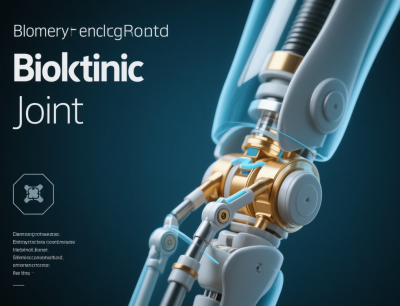
Bionic joints: definition and multidimensional analysis
Biomimetic joints are an engineered system that mimics the structure and function of biological joints, aiming to replicate or surpass the capabilities of natural joints in terms of mobility, adaptability, and durability through interdisciplinary techniques (e.g., materials science, biomechanics, robotics). Its design focuses on translating bio-optimized mechanisms such as lubrication, energy transfer, and dynamic response into artificial systems for use in healthcare, robotics, aerospace, and more.
1. Core Definition and Scope
- Biomimetic Essence:
Bionic joints not only replicate biological forms, but also analyze dynamic mechanical properties (e.g., cartilage viscoelasticity, synovial fluid rheology) and functional integration mechanisms (e.g., muscle-ligament synergy, neurofeedback control) to build adaptable, low-friction, and energy-efficient artificial joints. - Technical Objectives:
- Healthcare: Replace or repair damaged human joints (e.g., hips, knees) to address the wear, rejection, and short life of traditional prosthetics.
- Robotics: Enabling the natural movement of robots (e.g., bipedal walking, flexible gripping) and enhancing environmental adaptability and energy efficiency.
- Aerospace: Development of lightweight, high-reliability bionic joints for space truss assembly or extreme environments.
II. Design Principles
- Biological Models & Engineering Solutions:
Biological characteristics Biomimetic technology Technical Principles & Cases Cartilage lubrication Self-lubricating material / hydrodynamic bearing Bio-inspired synovial fluids (e.g., PVA hydrogels) reduce friction; Sealed lubrication chamber prevents leakage. Muscle-tendon antagonism Pneumatic Artificial Tendon (PAM) Festo DMSP tendons mimic contraction for joint stiffness and position control. Multi-degree-of-freedom motion Rigid-flexible coupling structure Silicone soft actuators simulate the bending and twisting of human fingers. Energy absorption Elastomeric material (e.g. E60 silicone) The bionic ankle combines a rigid frame and flexible materials to absorb impact. - Material Innovation:
- Metal: Titanium alloy (Ti-6Al-4V) predominates due to its biocompatibility and wear resistance, and is enhanced by surface modifications such as hydroxyapatite coatings.
- Polymers: UHMWPE and PU mimic cartilage viscoelasticity, and nanomaterial-reinforced materials such as carbon fiber increase mechanical strength.
- Bioactive materials: Drug-loaded hydrogels promote cartilage regeneration and are used in the treatment of osteoarthritis.
III. Applications and Case Studies
- Medical Prostheses:
- Case 1: Zirconia ceramic-polyethylene hip joints with a microstructured surface reduce wear and tear by 50%.
- Case 2: Injectable nanoconjugates repair cartilage defects in osteoarthritis models and inhibit MMP-13 inflammatory markers.
- Robot Joints:
- Case 1: A quadruped robot with antagonistic joints achieves a positioning accuracy of 0.6° through a fuzzy neural network.
- Case 2: A bipedal robotic ankle joint using PAM and silicone structure replicates a human gait on uneven terrain.
- Extreme Environments:
- Case in point: A space truss assembly robot integrates bionic rails to prevent component swings caused by microgravity.
IV. Challenges
- Dynamic Adaptability:
- Real-time environmental responses (e.g., knee stiffness during running) require advanced algorithms (e.g., reinforcement learning).
- Material Durability:
- Flexible materials (e.g., hydrogels) fatigue easily; Rigid materials, such as ceramics, lack biocompatibility. Gradient composites provide the solution.
- Energy Efficiency:
- Pneumatic/hydraulic systems lag behind bioenergetic conversion (e.g., ATP-driven muscles).
5. Future directions
- Smart Materials:
- 4D printed shape memory joints that respond to temperature or magnetic fields.
- Quantum biomaterials mimic molecular energy transfer to improve efficiency.
- Biohybrid System:
- Integration of living cells, such as cardiomyocytes, to achieve self-healing joints.
- Personalized Medicine:
- 3D printed joints tailored to the patient’s anatomy using CT/MRI data.
conclusion
Bionic Joints epitomizes the synergy between biology and engineering, addressing key challenges in mobility recovery, robotic intelligence, and extreme environmental work. Despite the material, control, and ethical hurdles, their breakthroughs in healthcare and robotics make them a key component of the next generation of intelligent systems.
If you are interested in purchasing this domain name, please contact: chuanchuan810@gmail.com





